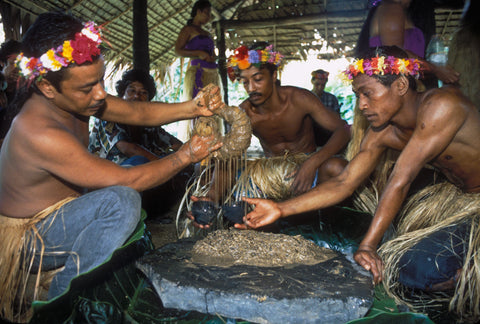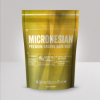Tyler
Kava Vendor
For the Kava drinker who has tried them all, introducing our Micronesian Kava powder, Micronesian Rahmwanger! Rahmwanger and Rahmadel are the only two Kava varieties grown in Micronesia. Rahmwanger is characterized as being a robust cultivar that is dark green and has thick black-spotted stems. Rahmadel has longer, thinner, lighter stems and is only used on special occasions. Rahmwanger, on the other hand, is a daily part of life in Pohnpei, Micronesia and accounts for more than 90% of the Micronesian market for 'Sakau'. Needless to say, it's a real crowd pleaser and you'll soon see why. It's smooth and potent with an excellent chemotype that leans towards strong physical relaxation. We're happy to be the mainland's EXCLUSIVE source for Micronesian Rahmwanger!
Sakau is the quintessential plant to Micronesian culture. When Pohnpeians are asked what their most distinguishing characteristic is from the other Micronesian islands, they will unanimously respond, "Sakau". Pohnpeian culture is so Kava-centric that the coconut shell into which the Sakau is poured and served appears not only on the Micronesian State flag, but on the seal of the governor of Micronesia. Roadside Sakau stands can be found throughout the capital of Pohnpei, selling 1-liter plastic bottles of freshly squeezed Sakau. Rahmwanger is the most common and most popular variety owing to its strongly sedating chemotype and consistent supply. Rahmadel is a specialty variety which is less commonly grown and drunk and represents more of a traditional Hawaiian chemotype.

(Above Micronesian men on Pohnpei pounding Sakau root on basalt pounding stone and squeezing Sakau through hibiscus fiber filter into coconut shells, All rights reserved)
One of the interesting features of the Pohnpeian kava culture is the traditional basalt pounding stones called "moahl" in which the Sakau roots are pounded for preparation. Very rarely do you see powdered or dried Sakau in packages. Rather, Sakau is always prepared from the fresh green roots and pounded on flat basalt sakau pounding stones in a harmonic, rhythmic, fashion among several drinkers. These basalt pounding stones are found in every kava drinking establishment, including homes, and are often passed down with great reverence from one generation to another. The pounding stones are flat and sound similar to bells when struck, the resonance itself becomes hypnotic and bonds the group before the Sakau is consumed. The rhythm is usually controlled by the senior Sakau pounder, who is usually the elder of the group, and can change the tempo as the process goes on, usually getting faster as the process nears completion. Taro leaves are usually placed around the stone to catch any of the precious root that may fall from the stone during preparation.
Once the roots are thoroughly pounded, they are strained through long strands of the inner bark and phloem layer of fresh sea hibiscus bark (Hibiscus tiliaceus) which contains a mucilage, useful for making an emulsion to better extract the kavalactones in order to make a very strong beverage. The hibiscus mucilage also imparts a slimy texture which helps to coat the palate and encapsulate much of the bitter and peppery principles in the finished beverage. On that note, Pohnpeians add very little water to their roots before squeezing directly into a coconut shell for drinking. Pohpeian Sakau is much thicker and much stronger than the preferences of most other kava drinking cultures.
Not only is Sakau made fresh and strong, but the average Sakau drinking session will last 5 1/2 hours for men in which an average of 8 coconut shells worth are consumed. When the average strength of a 6-ounce shell of Sakau contains approximately 500mg or more of kavalactones, Pohpeans are serious kava drinkers that will drink 4,00mg of Kavalactones per sitting!
Sakau is thought to maintain peace and community throughout the island while reinforcing the concept of "Wahu" or respect and hierarchy within the culture. Sakau is, therefore, a multifaceted instrument that is central to many events in everyday Pohnpeian culture. For example, "Sakau en Tomw" is the sakau offering and ceremony a family will perform when a member of the group offends a chief in order to offer an apology and ask for forgiveness. "Sakau en Pahnta" is the Sakau offering that is presented to a family by a young man who would like to ask permission to marry their daughter. "Sakau en Enihtik" is an offer to trade Sakau for regional medicine when one is sick. "Sakau en Olu" is the offering of Sakau to the supernatural realm for a wide variety of spiritual ills thought to be caused by offending deities and spirits.
As you can see, Micronesia and specifically Pohnpei, has a strongly Kava-centric culture. We're happy to be able to share this unique variety with our customers and we hope you enjoy it and appreciate the importance and reverence of this plant to Micronesians.

